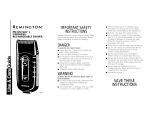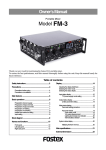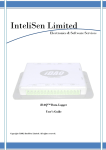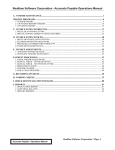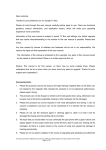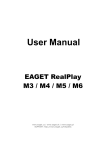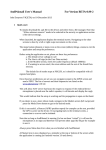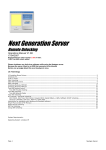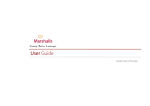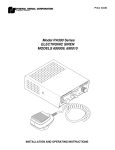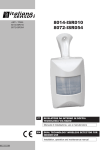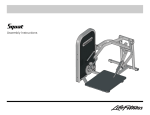Download UralTone Bias Tool Deluxe CBM-1 user manual v.1.0 – 9.1.2015 1
Transcript
UralTone Bias Tool Deluxe CBM-1 user manual v.1.0 – 9.1.2015 1. Features 1.1 The Bias Meter and biasing 1.2 Features and limitations 2. Preparation for the usage and choises 2.1 Preparation 2.2 Selection of the tube type 2.3 Selection of the amplifier type 3. Measuring 3.1 Anode dissipation in Watts 3.2 Anode dissipation in persentage from maximum allowed 3.3 Cathode current 3.4 Anode Voltage 4. Settings 4.1 Activating the settings mode 4.2 Reset to default values 4.3 Brighness and Contrast 4.4 Power Saving 4.5 Traditional Class AB Low limit / High limit 4.6 Modern Class AB Low limit / High limit 4.7 Class A Low limit / High limit 4.8 Class B Low limit / High limit 4.9 No Leds mode 5. Custom Probe 6. Technical information The Firmware of the meter may be updated from time to time. The latest version of the manual is found: http://www.uraltone.com/biasmeter 1. FEATURES 1.1 The Bias Meter and biasing UralTone Bias Tool Deluxe is inteded as tool biasing tube amplifiers. It measures the cathode current (Ik) and anode voltage (Ba) where the anode dissipation is calculated from. The dissipation (power) is calculated with formula Pd=Ba*Ik. When the output tubes are biased, the current flowing in no signal conditions is adjusted to wanted level for the amplifier under adjustement. The proper level of bias current changes from amplifier to another and by type of the tubes used. For manufacturing reasons electrical parameters of the same tube varies. Tube suppliers measures and matches the tubes prior delivery to customers, but it may be possible the customer does not get exactly same set of tubes due these differences. This is the reason fo biasing the amplifier when the tubes are reaplaced. When the bias is set, the operational point of the tubes are set right. This is based on technical parametes of the tubes and recommendations of the amplifier manufacturer. The rest is just measuring and math. UralTone Bias Tool Deluxe has programmed most usual power tube types and four biasing targets or amplifier types, as we prefer. The voltage and current flowing the chosen output tube is measured where the anode dissipation is calculater from. This result is compared to chosen amplifier type which gives the range for OK result for proper bias. The user interface is done by three led illuminated push buttons. The two buttons on left and right works as previous and next selectors and the one on middle is used for selecting or jumping back depending the what user is doing at the moment. The UI loops following: 1: Selection of tube type (select: previous tube, proceed, next tube) 2: Selection of amplifier type (select: previous style, proceed, next style) 3: Measure (select: previous page, return to start, next page) The Leds on the buttons views the proper bias level: blue = cold, under the ideal biasing level white = ok, whitin the ideal biasing level red = hot, over the ideal biasing level all leds on = danger, maximum values of the tube are exceeded (current or anode dissipation) Led-display displays the level of the bias by the tube dissipating more power, so if the tubes are badly mismathced the output of the led display may look fine. The numerical values needs to be checked when the biasing is done. The LCD display shows measurement results from both channels, upper is CH1 and lower CH2. 1.2 Features and limitations The Bias Meter can measure anode voltages up to 999V and cathode current up to 99.9mA. These are limited by the character space on display. If you are not sure if the meter is suitable for measuring the amplifier to be biased, contact us before usage. The safest way is just use the meter only those tube types which are preprogrammed in the memory. It's not possible to measure the cathode biased amplifiers which have separate cathode resistors for each tube. Both inputs are internally connected by the ground pin (cathode) so using the meter will short circuit the cathode voltage to same level. The meter does not suit for the amplifiers which exceeds the maximum current of voltages of the meter. The Bias Tool is not a tool for fault finding. If the amplifier or the output tubes are broken, there is possibility of braking the meter or the probes. Use the meter only for adjusting the working amplifier. The maximum voltage on the plugs is less than 1.1V when the meter shows the maximum values. Do note, if you're using cathode biased amplifier, the potential on the plug is same as the cahtode voltage. (Usually less than 30V) 2. PREPARATION FOR THE USAGE AND CHOISES 2.1 Prepararion Both probes are inserted between the tube socket and output tube. Always do the connections to unpowered amplifier. If the amplifier has two or multiple pairs of tubes, select either two on the middle or two on the sides for getting measures from both sides of the push pull stage. Wrong inserting doesn't hurt, both channels will just display the same result. Connect the probe plugs to the meter and switch on the power. Dial all volume etc. potentiometers to zero to make sure there is no signal on output. Possible signal on may cause false readings. When all preparatins are done, swich on the amplifier. 2.2 Selection of the tube type When the meter is swiched on after the short welcome text and led test user is promted to select the power tube type used on the amplifier being biased. The Bias Meter has small database of most usual octal and noval type power tubes. Among the tube type the maximum anode dissipation (W), anode voltage (V) and anode current (mA) is displayed. Please note: Some amplifiers will exceed the maximum values for purpose so regard these values as guide lines if the amplifier is well known. It's possible to do the measurement with the ”wrong” tube. By this the anode dissipation in persentage will display wrong figures. This won't prohibit the biasing, if the user has needed data from the tube being used. 2.3 Selection of the amplifier type Next step is selecting the wanted level of anode disipation. This choise is done by preselected styles. These styles are based on different amplifier classes and experience how the modern or old amplifiers are build and done. The meter has four different styles: Traditional AB-Class (Trad. Cl. AB) Traditional AB-Class is inteded for older guitar amplifiers, such as most of Fenders and Marshalls, where the tubes are set to run relatively hot. The biasing target is 50 70% of the maximum allowed anode dissipation. Modern AB-Class (Mod. Cl. AB) Modern AB-Class is selection for newer amplifiers (many high gain models, such as Engl, Peavey and Mesa boogie), which most are biased so cold so these basically may except fresh set of tubes. They still sound better with proper biasing. Usualy these amplifiers have smaller output transformers so the biasing target is lower 40 50% for maximum allowed. Class-A (Class A) Class A is seldom used class, but has it place in known amplifier classes. In class-A both tubes are conducting continously and the current is high. Biasing target is 90 100%. Class-B (Class B) Amplifiers working in Class-B are not so common either, for example hybrid Music Mans, where the tubes are set to work in high operating voltages (750V), but in low current. Target range is 10 – 20 %. No class (disable leds) This ”fifth class” is intended for those purposes the meter is used with other tubes than programmed in the memory. This disables the led display. Despite the meter gives easy way for setting the bias level close to the maximum level, we don't recommend to exceed the recommendations given by the amplifier manufacturer. Modern amplifier biased to work in Class-A won't stand the large current drawn by tubes and will cause premature failure of power or output transformers. Next to measuring data it's always suitable to use own pair of ears. Too hot tubes are worn in shorter time. If the amplifier sounds equally good set to work in 50% anode dissipation there is no need to set it work in 70%. 3. MEASURING The Bias Tool has four different measuring modes. Except for the voltage measure all of the modes may be used for setting right bias current. 3.1 Anode dissipation in Watts (Display: Pd:) Anode dissipation is measured in Watts. Right after the readout there is indicators for biasing ranges: LO: Too low, OK: proper, HI, Too high, !!: way too high The Led display uses the same steps except only the one taking more current is shown. When the maximum levels are exceeded all leds are on. 3.2 Anode dissipation in persentage from maximum allowed (Display: Pt:) Anode dissipation may be measured as percent of maximum allowed. Right next to readout is the maximum dissipation in Watts of the selected tube. 3.3 Cathode current (Display: Ik:) The readout of the cathode current (anode current + g2 current) of both tubes. If the maximum allowed current is exceeded ! is shown next to the readout while all leds are on. 3.4 Anode voltage (Display: Ba:) The readout of the anode voltage is shown on both channels. (This is the readout of between the anode and cathode, so the raised cathode potential is not measured on cathode biased amplifiers. For measurement purposes this has no relevance.) Then the voltage exceeds the maximum allowed ! is displayed next to the readout. These pages may selected from previous and next buttons. The middle button retuns back on the tube select page. When the amplifier is set switch off the power and let the amplifier cool for a while so the probes can be removed. 4. SETTINGS 4.1 Activating the settings mode The meter has some user settable parameters for setting the meter suitable for personal usage. To enable the setting mode, keep the previous and next buttons pressed while powering the meter on. After the ”Setup enable” welcoming buttons may released. 4.2 Reset to defaults (Display: Reset to dft). This resets all parameters to factory values. If you have purhaced the meter as second hand, we recommend to reset it prior usage. Resetted meter will boot with ”UralTone First Boot” welcome message. 4.3 Brighness and Contrast Both Brighness and Contrast may be set in wanted level. New value is stoded to permanent memory when the value is entered by pressing the center button. 4.4 Power Saving The meter will shut down the back light and leds after the selected time for saving some battery power, if the maximum values are not exceeded. The meter will reming the user to swich off the power of flicking led in 10s. intevals. Power save is bypassed with 0 min. value. 4.5 Traditional Class Low limit / High limit The four styles may be set for different rages, if the factory values aren't the best for the spesific need of the user. This feature is intended for example repair shops specialized in certain models of amplifiers. Please remind the altered ranges does not meet the original idea of certain styles. Please check these values before using the meter and reset if needed. Traditional Class AB Low limit (Display: Lo threshold Tr. AB:) default value 50 % Traditional Class AB High limit (Display: HI threshold Tr. AB:) default value 70 % 4.6 Modern Class AB Low limit / High limit Modern Class AB Low limit (Display: Lo threshold Mod AB:) default value 40 % Modern Class AB High limit (Display: HI threshold Mod AB:) default value 50 % 4.7 Class A Low limit / High limit Class A Low limit (Display: Lo threshold Cla. A:) default value 90 % Class A High limit (Display: HI threshold Cla. A:) default value 100 % 4.8 Class B Low limit / High limit Class B Low limit (Display: Lo threshold Cla. B:) default value 10 % Class B High limit (Display: HI threshold Cla. B:) default value 20 % 4.9 No Leds mode The no Leds mode is enabled / disabled here (Display: No leds meas). Note: No leds mode disables the maximum value three led warning off as well. 5. CUSTOM PROBE It's possible to make custom probe for the meter, other than octal or noval based tube or integrate the measurement output in the amplifier. The cathode current is measured from the cathode with the series 11ohm resistor. (two 22ohm resistors in parallel) The amplifier end of the resistor is connected to plug sleeve (GND) and cathode end to plug tip. The voltage is measured with the resistor divider 4.7Mohm / 4.75kohm. The 4.7Mohm resistor is conected to tube anode and other end to plug ring. The 4.75k resistor is connected from the ring to plug sleeve (ground). The ratio is roughly 1000:1 so select the resistors by hand for maximum precision. The values are selected so the meter input is approx 1.1V when the maximum readout is reached. (999V or 99,9mA) PLEASE NOTE: The maximum input range fed to meter may not exceed 0-5V on any conditions. Faulty or wrong made probe may broke either the amplifier or the meter. UralTone does not take any responsibility of user made probes. Probe schematic 6. TECHNICAL INFORMATION – – – – Four channel voltage meter with biasing arithmetics functions. Powered by 9V battery, corrent consumption approx. 55mA with full bright back light and three indicator leds on. On power save approx. 35mA Measuring range 0 – 1.1V (ADC reference voltage) Maximum input range 0 - 5V







